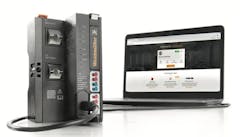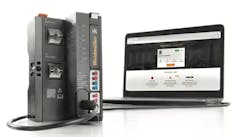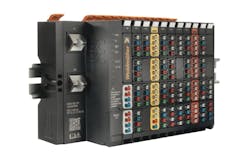Using Open Systems for Industrial Automation
Having covered the increasing use of open software and systems in industry over the past several years now, it’s easy to see how u-OS (an open operating system designed to handle tasks such as device maintenance and application integration in automated systems) is a great example of how integral the use of open systems technologies is becoming across the automation device landscape. But not so long ago, the idea of using open systems technology wasn't exactly widely embraced by the industrial engineering community.
With this background in mind, we connected with Ken Crawford, senior director of automation at Weidmüller USA, for an episode of our podcast series, Automation World Gets Your Questions Answered, to learn more open system use in industrial automation and understand better how Weidmüller is addressing this evolution across a number of technologies.
AW: What are the risk of open source software in automation today and what is Weidmüller doing to mitigate these risks?
Crawford: Just because hackers can't see the source code [in a proprietary system] doesn't mean that it's more secure by any means. And, by some estimates, 90% of the industrial community uses some form of open software today. Open-source software has the largest developer community contributing to and patching the Linux-based OS as well as the other open-source platforms like Python and Node-Red. At last count the Linux foundation estimated the number of developers to be over a million. A proprietary developer can't achieve that level of creative support.
Weidmüller engages with these open-source communities, and we have partnerships and tools that provide us with alerts to any vulnerabilities that may be present as well as help us rapidly patch our solutions. And with this level of engagement with the open-source community, we are seeing an explosion of unique and creative open-source solutions that are more flexible and extensible than any kind of closed counterpart could possibly be.
AW: Since many industrial engineers may not be as comfortable with Linux as other operating systems, do you see Linux as being a good fit for a broad range of industrial automation applications?
Crawford: Weidmüller recognizes that Linux can be a little more difficult for engineers who are not as IT literate as a typical Linux administrator. That's why we’ve abstracted a lot of the Linux portions from the user interface so that you really don't have to understand Linux. We provide applications that limit the need for the user to interact directly with our OS, thereby extracting the need for the user to have any interaction with Linux. Another benefit to our open system approach is that u-OS enables OEMs to run third-party applications that can coexist on the controller and provide enhanced controller functionality. For instance, we support a platform called AnyViz, which provides condition monitoring visualization and cloud connectivity right out of the box.
These open-source platforms supported by Linux make u-OS a very flexible and extensible platform without the need for in-depth software development experience or knowledge of the platform itself. You just take these modules and load them on our containerized OS and you can run that application with all the dependencies and drivers and applications associated with the module housed in that container. So, the ability for the containers to isolate each application running in conjunction with the main control algorithm provides an isolation barrier that enables the control features to be deterministic and run analytics and other applications independently in a multi-threaded environment and keep it all very safe.
AW: I'd like to dive into the OEM aspect you mentioned. Can you explain more about the business-side benefits of an open systems approach for OEMs?
Crawford: Because u-OS runs on a PLC, you can do a lot more with that controller than have it just be a PLC— and it does it in a way that simplifies the platform.
Years ago, if you wanted a platform that was cloud connected, you'd have your PLC platform but then you'd have to buy a gateway or a cellular modem and then buy some kind of firewall device. With u-OS, since it is a cloud-connected OS, we incorporate a lot of those individual parts and pieces and software modules on the PLC itself. That way you get a lot of bang for your buck with a very reduced BOM cost.
Also, since u-OS was built from the ground up as a connectivity platform, it allows for a high level of integration to deliver many Industry 4.0 benefits all in a PLC that offers traditional discrete and process level control as well as state-of-the-art VPN-level security.
Many OEMs still don't have fleet and edge management capabilities for their remotely deployed assets to maintain, diagnose and troubleshoot them on one platform. This is a key factor for OEMs because fleet management allows you, from one central location on one single pane of glass, to see how your machines are operating and get a quick glimpse of how well your fleet is performing at any time.
A lot of OEMs we work with are smaller OEMs and they recognize the benefits of Industry 4.0, but they don't necessarily have the resources or expertise to adopt a lot of these technologies. We've combined our u-OS a cloud connected platform with our applied solutions network—our ASN team of field engineers who work with the OEMs to intertwine our solution into the OEM's existing infrastructure—to really extract the value of cloud-based u-OS connectivity by setting up the tag map and dashboards to help these smaller OEMs realize exactly what the platform has to offer.
This really enables the smaller OEMs to capture some of that competitive differentiation that the bigger boys are offering and helps the small OEMs look big.
AW: The whole idea of fleet management or equipment-as-a-service from an OEM point of view has been a game changer in the OEM industry over the past few years and we see no signs of this slowing down. But what about end users? How can these technologies help their operations?
Crawford: So let's take problem detection as an example. With u-OS's ability to host and run third-party applications, users can, for example, install a data aggregation application alongside Codesys on the PLC with the ability to continuously gather metric information that enables them to detect problems and trends in their equipment. In this way, users have their core control algorithm that's running a piece of equipment and can then easily load a third-party analytics application to perform problem detection. And that analytic application can coexist with the control algorithm, collecting data and sending it up to the cloud allowing the user to see trends in their equipment portfolio to detect problems early and rectify them. This technology can also be used to optimize a program remotely and update it in a way that allows users to address any problems locally at the edge.
With detection comes prediction and with prediction the user can better determine issues before they become downtime events.
AW: Can these open-source technologies help address the loss of in-house expertise as Boomers retire in greater numbers and address new workforce trends around remote work and employee retention?
Crawford: Many industries are seeing their workforces retiring and with that the exodus of decades of experience. With the introduction Industry 4.0 comes enhancements through more intelligent machines, but those insights require a broader sensor deployment as well as a highly trained workforce. So, in an environment where employees are sprinting for higher wages and with little company loyalty, it's imperative that OEMs and end users employ a technology that's easy to learn, is easily configured and is expertly supported with a central team of control engineers. u-OS offers the ability to remotely log in, diagnose and update control applications from a central location and even be accessed by Weidmüller tech support if needed. This lessens the impact for resource-constrained users and opens up the possibility for remote work staff to add value remotely instead of having to go onsite.
AW: Can you give us a couple of examples of users in different industry verticals that have used these open-source technologies to digitally transform their operations.
Crawford: An oil and gas OEM wanted to add tank monitoring around the production of its anti-foaming chemical used to keep oil flowing. This kind of monitoring could not be done by modifying a control cabinet because those cabinets were certified. So, u-OS gave them the opportunity to find a local vendor with a tank level sensor and then run that sensor company’s application alongside the control algorithm and connect that to the cloud remotely. There was no need to modify or add components to the control cabinet with u-OS and it allowed the user to do automatic inventory on its anti-flow agents.
Another example is a crane company that offers update services for its crane installations. These big industrial crane systems cost anywhere from $4 to $12 million and no two crane systems are typically the same. By standardizing on u-Control, this company connects u-remote and u-control parasitically to each one of its cranes’ design architectures and aggregates and analyzes the data via secure remote access through a central dashboard. This way, it doesn't matter if there are 10 different installations—they're all represented with the same look and feel on the dashboard.




